Objective
Health beliefs and cultural practices affect the health outcomes and:
- Perception of life and death;
- Diseases and their causes;
- Experience of illness and pain;
- Attitudes towards health professionals;
- Cultural bias in relation to the treatment;
- Preferences for managing and addressing a condition.
Culture is an integral part of one’s identity, which is based on the customs and ideas shared among specific groups. Since culture has an essential meaning in the context of one’s life, this element inevitably has a significant impact on health-related issues and their view. For the purpose of this presentation, one cultural group was chosen for an in-depth analysis and various aspects connected to spirituality, specific practices, nutrition, family patterns will be reviewed. The purpose of this presentation is to explore the cultural patterns of the Chinese population, especially those relating to the perception of health.
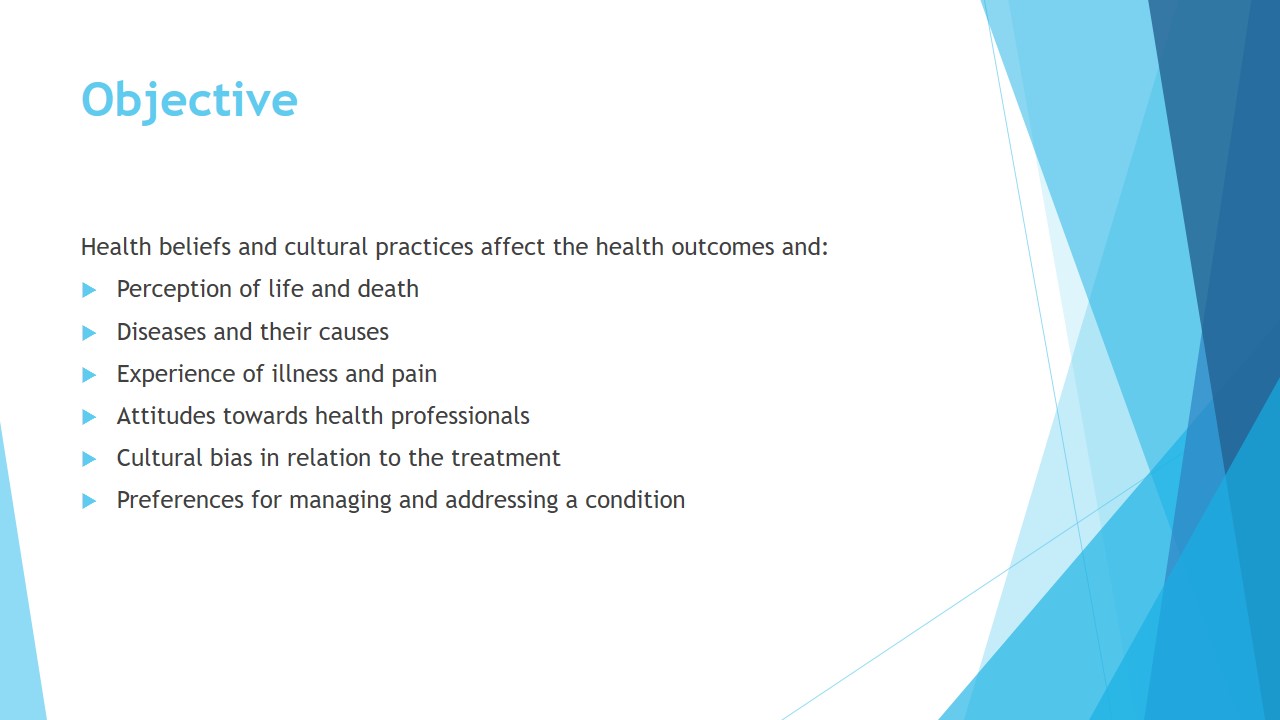
Health Beliefs and Practices
Key attitudes towards health:
- The connection between the external environment and one’s health;
- The consonance of a person’s energy with other elements;
- Disharmony leads to the development of diseases;
- Death is regarded as an ordinary element of one’s life;
- Collectivism is a crucial element of this culture;
- The consequences of personal actions for others are vital (Lim, 2015);
- Ying and yang concepts.
In Chinese culture, the essential element explaining the health-related attitudes is the perception of a human body and environment as one. Hence, the primary objective that results in well-being is to be in harmony with nature. Based on this, the perception of illness that this cultural group has is connected to the notions of harmony and disharmony. A disease is a result of the dissonance between a person and his or her surroundings, and therefore, the main focus of treatment is on restoring the balance (“Chinese culture,” n.d.). Interestingly, death is not feared by this cultural group because the Chinese see it as an integral part of life.
A broader perspective should be taken to fully understand how Chinese view well-being and which factors are essential in the decision-making process. The two critical differences that distinguish cultures is their focus on society as a whole or an individual (“Chinese culture,” n.d.). This cultural group emphasizes collectivism, meaning that unlike individualistic people, the Chinese are primarily concerned with the effect that their choices will have on others. In the context of care, this may mean that people can refuse treatment if it burdens their family members. The concept of yin and yang, vital for understanding the health beliefs and practices of the Chinese describes two opposite forces that continuously interact with each other.
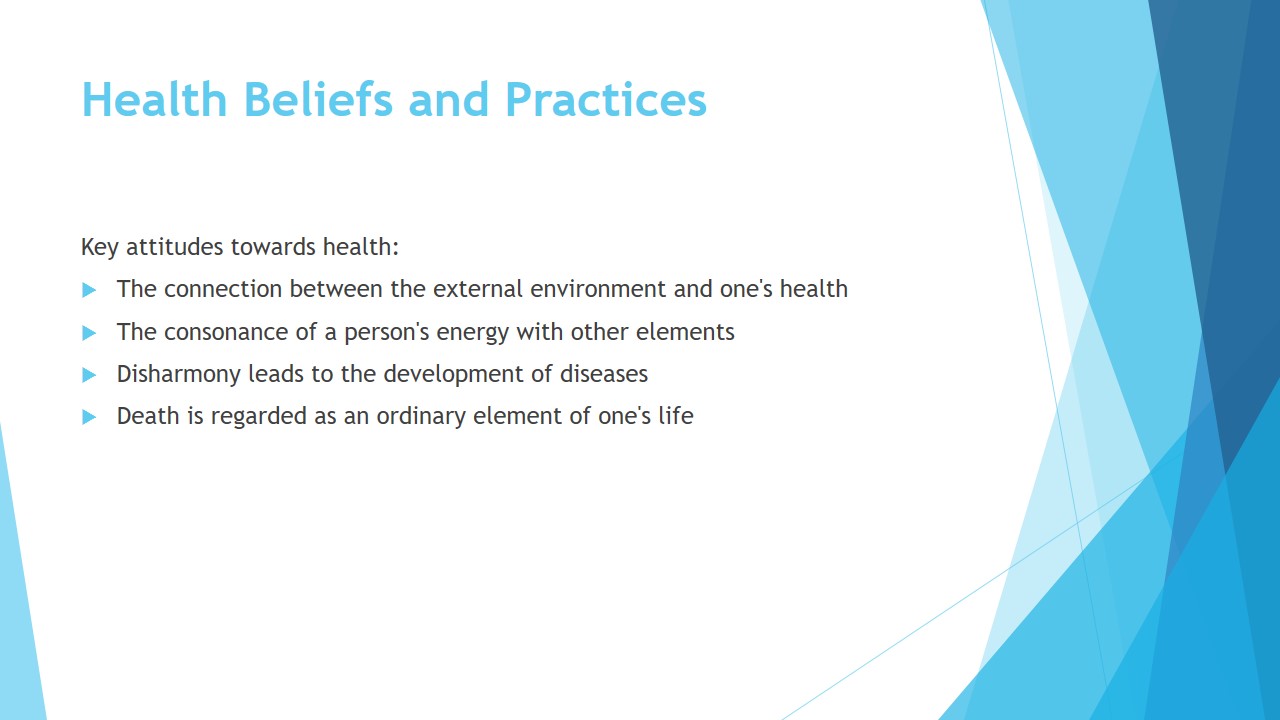
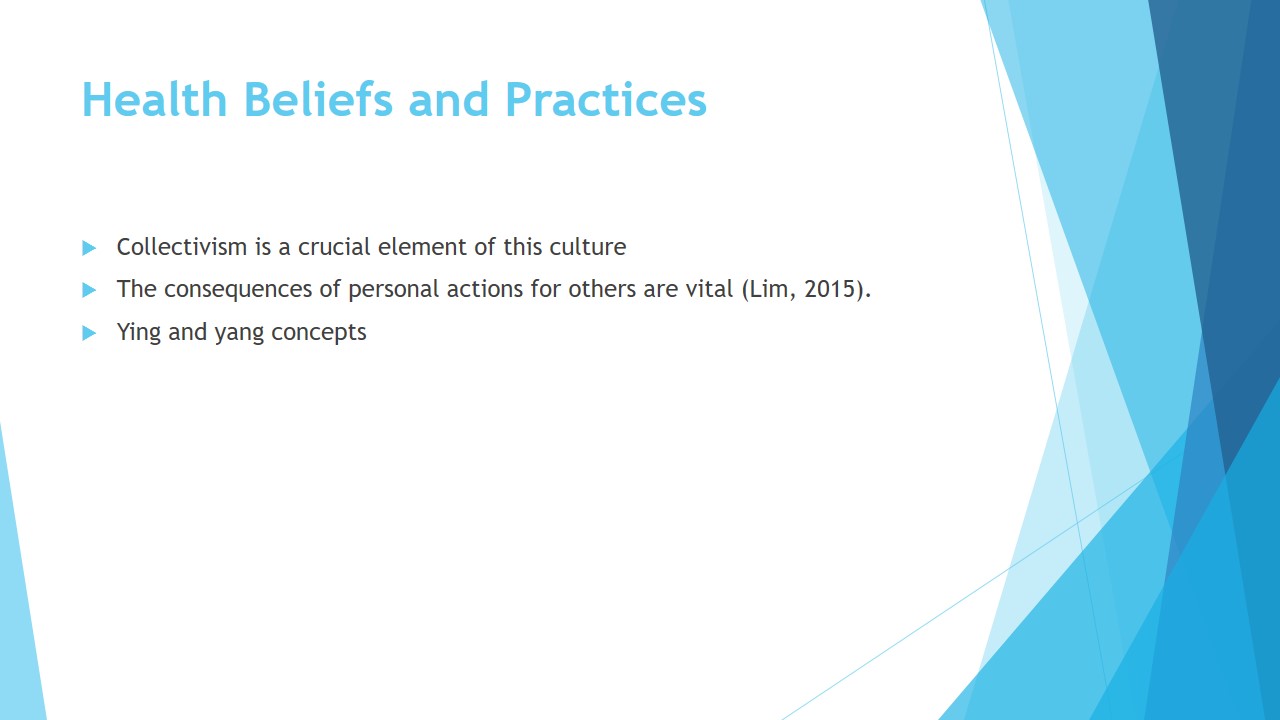
Family Patterns
- Key features of a Chinese family:
- Collectivistic approach to the perception of the society;
- Nuclear family approach (two parents and their children);
- Family is part of one’s identity (“Chinese culture,” n.d.);
- Individuals in Chinese culture must:
- Honor elders and children have to respect their parents;
- Obey the decisions made by their families;
- Understand that interests of the family exceed personal;
- Adhere to gender role standards (“Chinese culture,” n.d.).
As was mentioned before, the Chinese base their culture on the view of an individual as an integral part of a social group, for instance, a family. This is contrasting to the standard approach of individualism in the United States. Nuclear family, a notion that describes two adults and their children as basic social units is a vital part of the Chinese culture. In essence, for a person belonging to this culture, group relatives are a determinant part of self-perception, which undoubtedly affects the choices related to health. It can be argued that Chinese individuals would rely on group decision making when considering treatment options.
Based on the brief review of the key elements that describe the Chinese family patterns, it can be argued that family values are vital for this population. Hence, all decisions and treatment or management approaches should be made and discussed within the context of this pattern. This can be a beneficial feature since family members will provide support and guidance to a sick individual when necessary. In regards to gender roles, the typical family pattern within this culture is a patriarchic one where the father of a family has a lead role when making decisions.
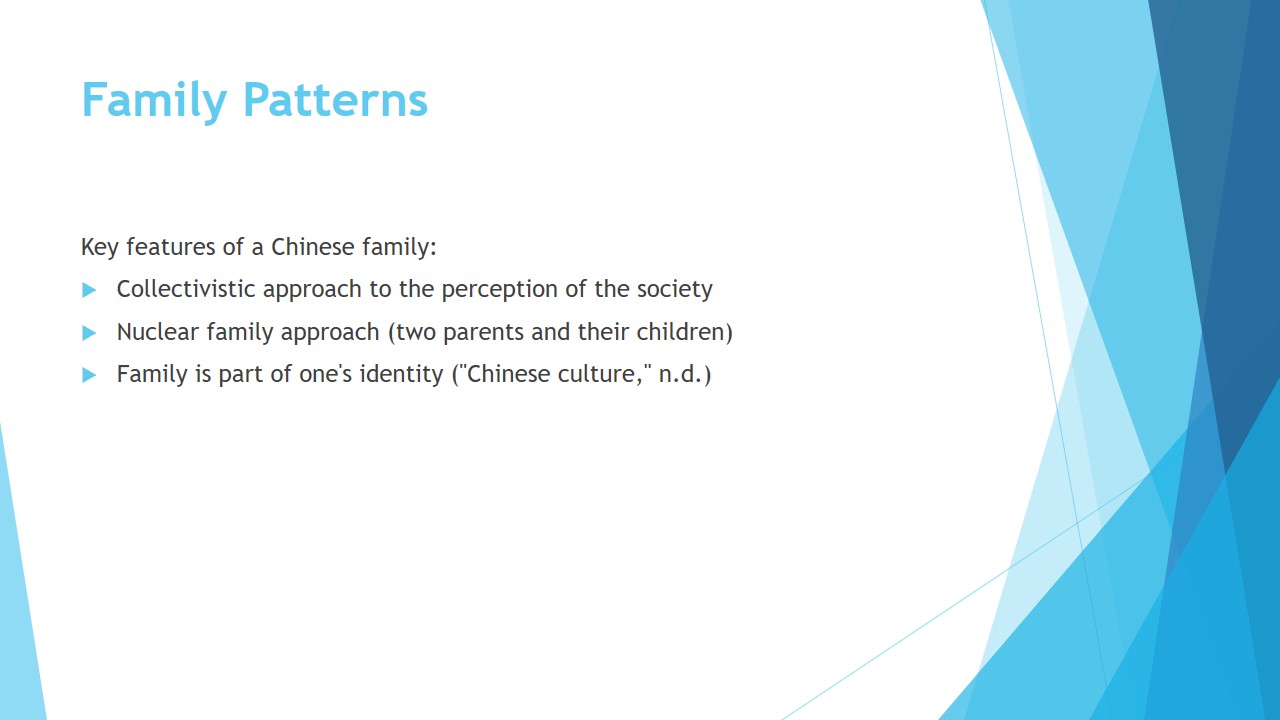
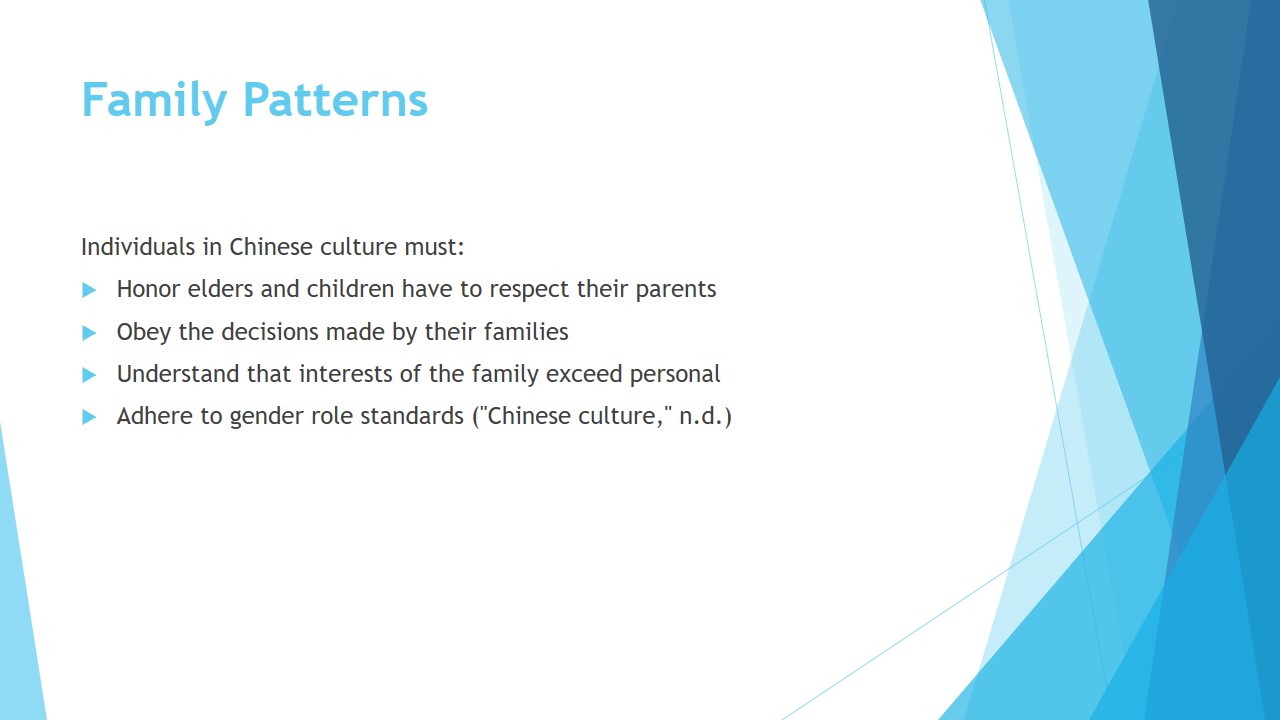
Communication Style
- Indirect communication (posture or gestures).
- Harmony within interpersonal relations is vital.
- Direct refusal is commonly avoided.
The approaches to communication are vital in the context of care provision because they affect the perception of a disease and the necessity for treatment. The specifics of the Chinese culture dictate the need to pay more attention towards the indirect communication features, for instance, face expressions, tone of voice, or specific gestures (“Chinese culture,” n.d.). Therefore, the non-verbal aspect of interpersonal communication may be perceived as more important by this group. Another aspect that has to be considered is the need to maintain harmony, which may result in misunderstandings. It is better to check if both parties understood each other correctly and clarify uncertainties within a conversation. One example of such an issue is the fact that the Chinese often do not say “no” but instead explain their position.
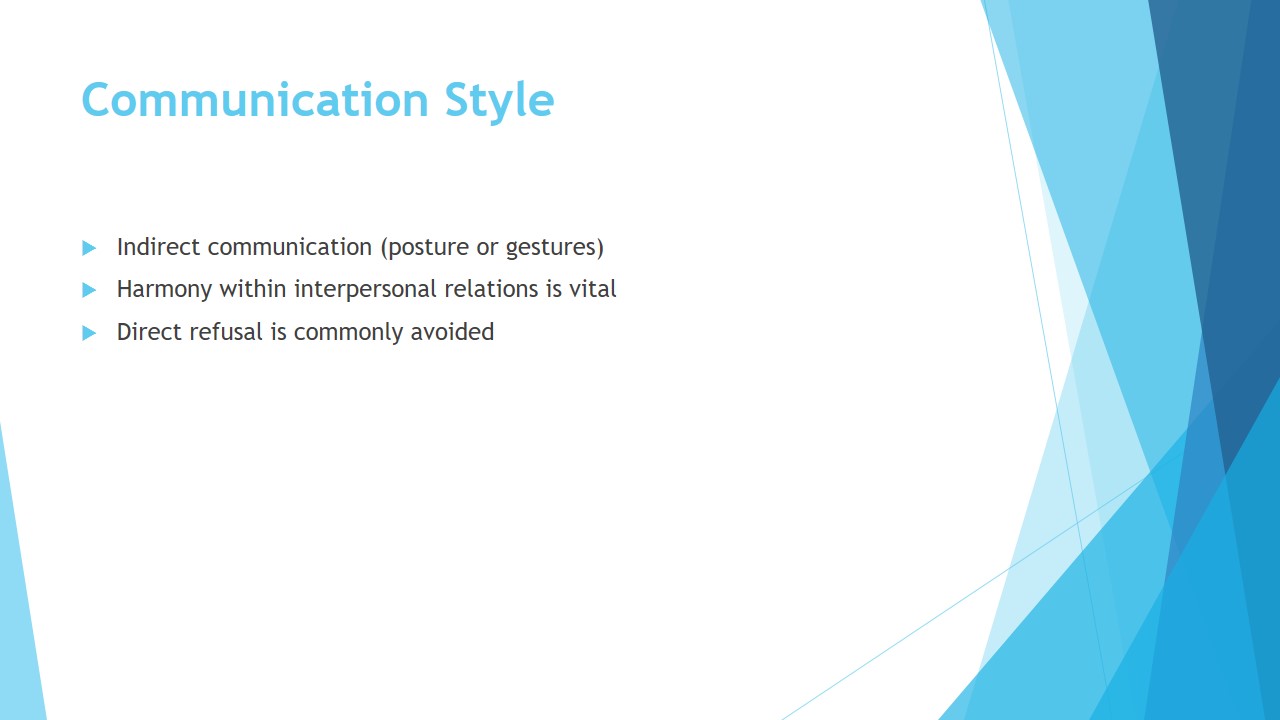
Space Orientation and Time Orientation
- Understanding of space concept in Chinese culture:
- Personal space is viewed differently;
- Proximity to another individual is common;
- Families often prefer to stay close to their relatives;
- Time perception specifics:
- Highly valuable and appreciated;
- Not perceived as linear (Khlyshov, 2016);
- Focus is on performing a task perfectly.
An important aspect that allows understanding the Chinese culture group is their understanding of space, more specifically personal space of themselves and others. In general, people from this group will be more close to each other when performing daily activities, for instance, working or eating (“Personal space in China,” n.d.). This may be unusual for people in the United States who are used to having much personal space. This may be connected to the preferred style of communication of this group that incorporates many gestures or touching another person when explaining something. Thus, the Chinese will prefer to be close to a person they are talking to in most cases.
Perception of time within the Chinese culture differs from that in Western, which may lead to many misunderstandings. The contrast is that for Chinese individuals, time is significant, although they do not view it in connection to money (Khlyshov, 2016). For instance, in the United States, many professionals receive a set hourly rate for their work, indicating the view of the financial aspect of money. In China, however, the focus is on the task that has to be performed, regardless of the time. Therefore, an important consideration here is that in a healthcare setting, the Chinese may require more time for a particular procedure or consultation.
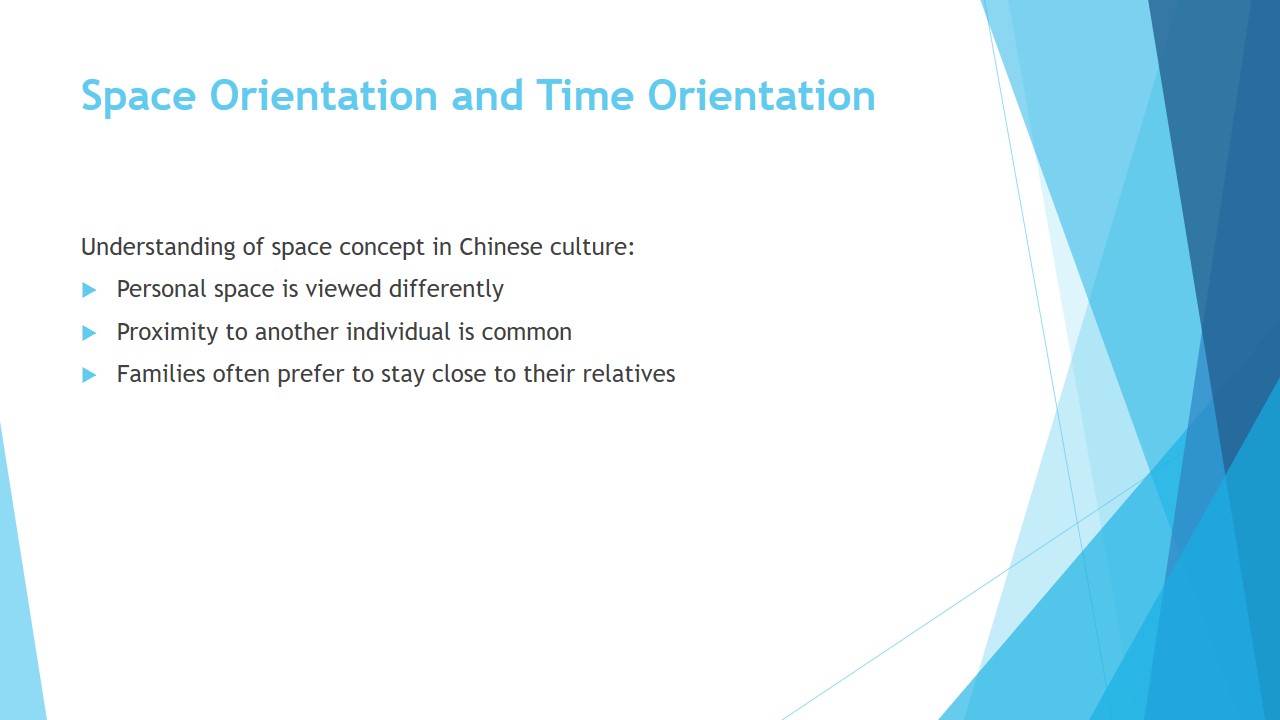
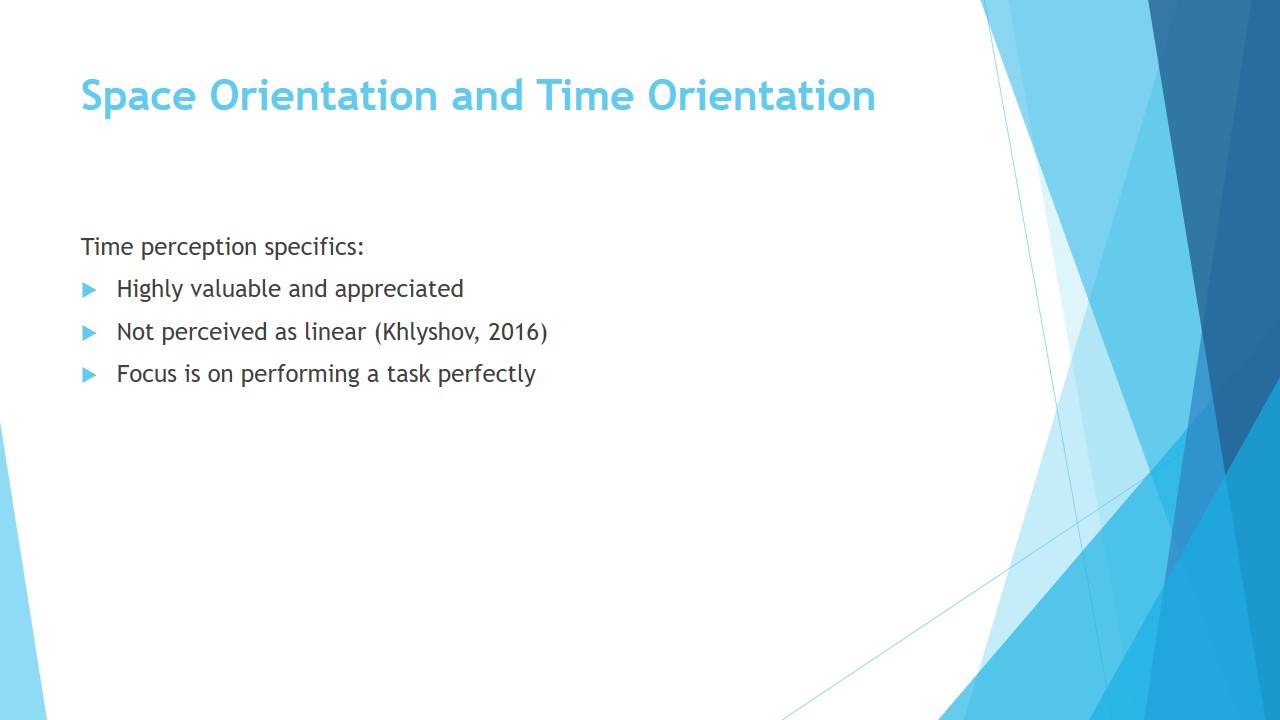
Nutritional Patterns
- Food classification incorporates either hot or cold dishes (“Chinese culture,” n.d.).
- A balanced diet is typical, based on the needs of an individual.
- High prevalence of lactose intolerance (“Chinese culture,” n.d.).
Nutrition can be a crucial factor when managing many chronic conditions, for instance, diabetes, and it is necessary to understand the specific patterns and or food preferences of this cultural group. For the Chinese, food is consumed to fulfill a specific need of a person, which corresponds with a general view of a healthy diet. In most cases, they will prefer rice or noodles as opposed to pasta and bread, which are common in the United States hospitals (“Chinese culture,” n.d.). Additionally, soymilk and tofu are often consumed as a substitute for milk because of lactose intolerance. Soup is perceived as a food that can provide the necessary energy and is often used to comfort sick individuals.
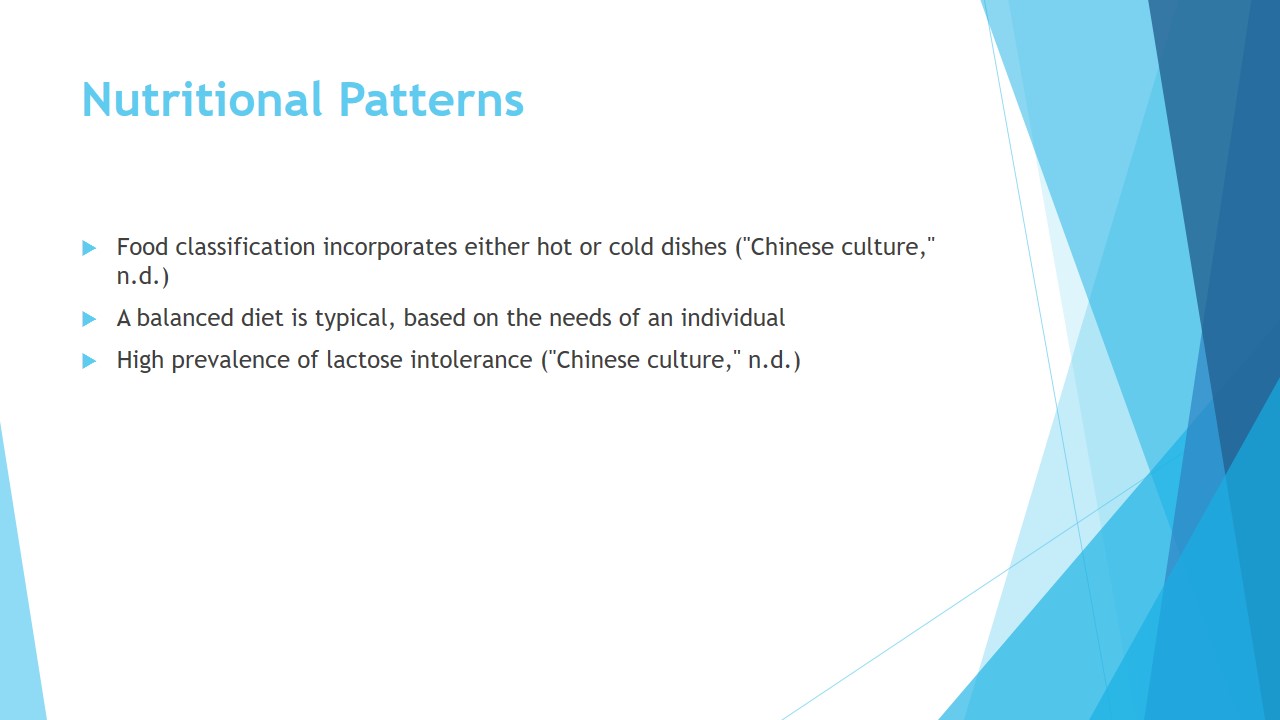
Pain Responses
- Fear of addiction is common among this population (Tung & Li, 2015).
- May deny the pain or avoid expressions of it.
- Some perceive pain as an inevitable part of life.
The perception of pain is connected to the religious and philosophic beliefs of the Chinese. For instance, those who value stoicism will not vocalize their pain and may even deny experiencing it, which can be a barrier to diagnosing and treating a condition. Some research indicates that Chinese American patients with cancer fail to adequately control their pain levels because of non-adherence to recommended medication (Tung & Li, 2015). Those adhering to the Buddhist beliefs view pain as an integral part of life and do not perceive it as unusual or something that needs to be addressed. In essence, this information leads to understanding that the Chinese population requires additional attention within the context of pain management.
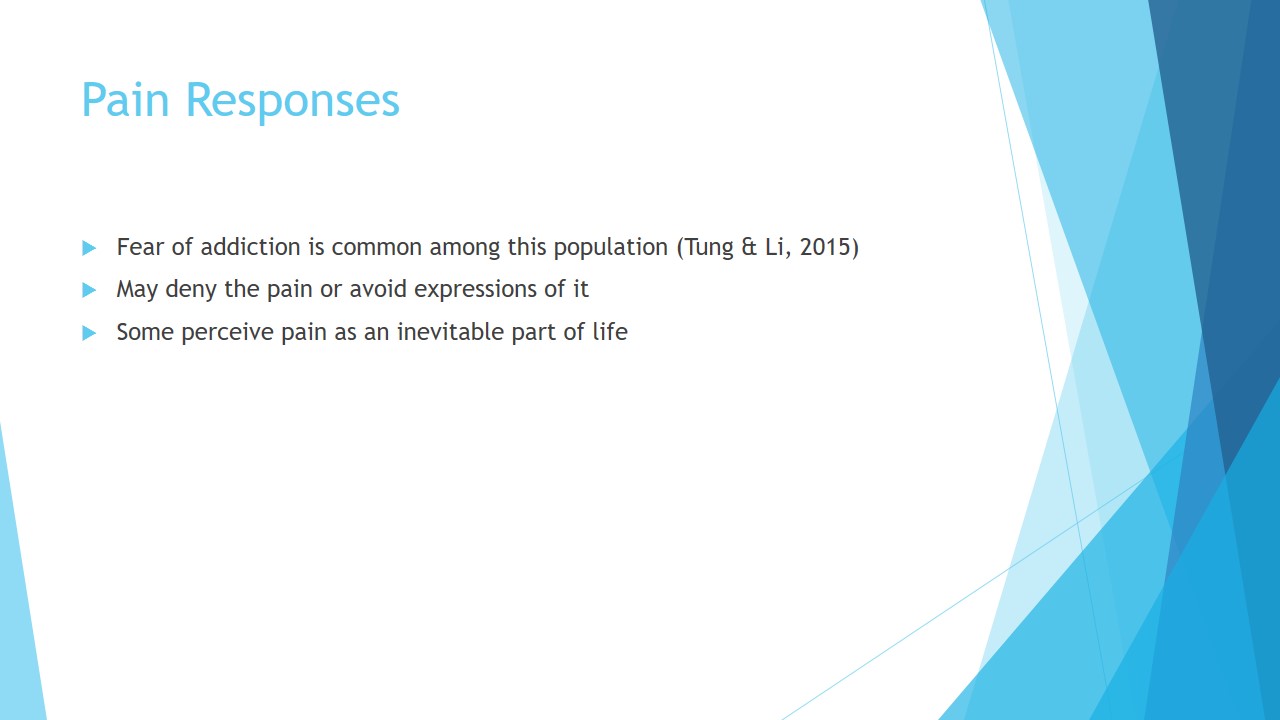
Childbirth and Perinatal care
- Pregnant women depend primarily on the help of relatives.
- Independence is not perceived as a positive feature.
- Special diet and behavioral approaches are present.
- Some women chose to follow infant traditional infant care practices.
Due to the specifics of this culture, some pregnant women may perceive standard care as improper. The general approach within this group is to cater to the needs of a woman while she is pregnant, which is inconsistent with the encouragement for independence prevalent in Western culture. The pregnancy is viewed as something that distorts a natural balance and to maintain it, the Chinese use specific practices connected to their dietary patterns and behavior to restore this balance, which should be considered by caregivers. Traditional infant care practices are usually advised by older members of a family; for instance, a child an a mother may be separated for 24 hours to let the latter rest.
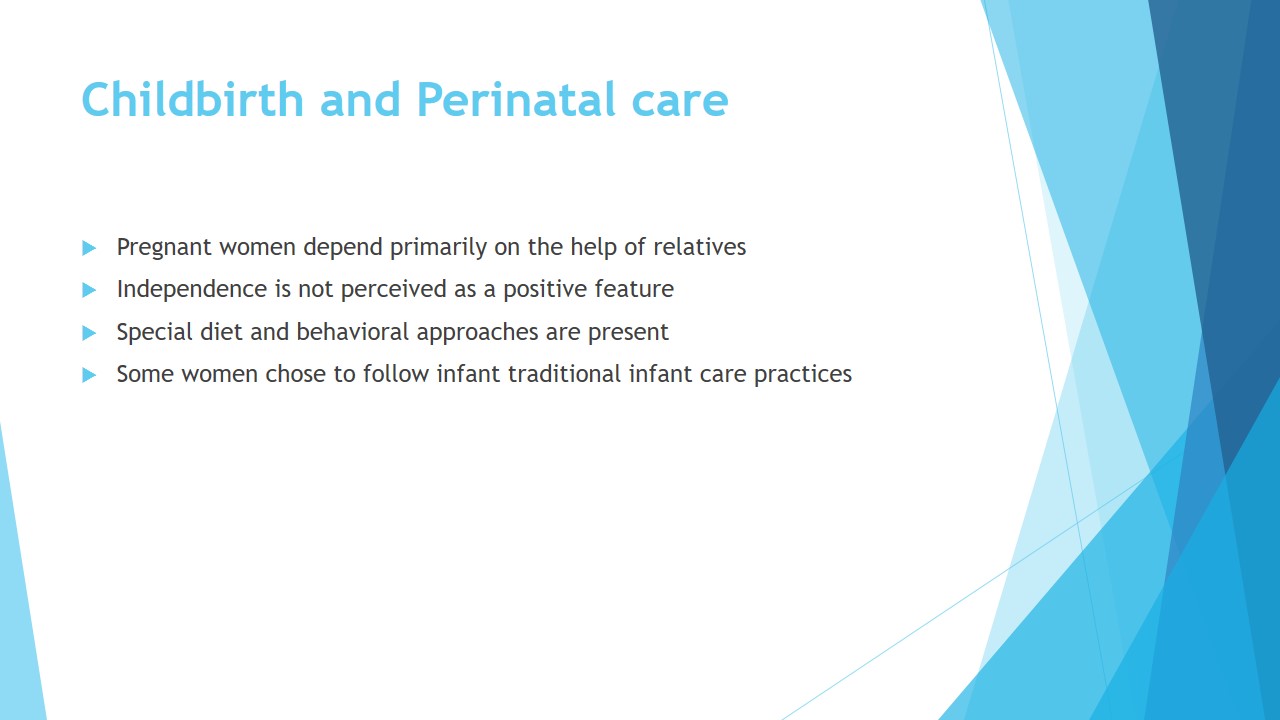
Death and Dying
- Proper funeral arrangements are necessary.
- Young people and babies are buried “in silence” (“Chinese culture,” n.d., p. 4).
- 3rd, 21st, 35th, 49th, and 60th days are ceremonial.
As was mentioned previously, the Chinese do not usually view death as tragic. In most cases, they perceive it as a natural aspect of life, which is consistent with the views of Buddhism. Due to the adherence to religious beliefs, this group values proper arrangements for funerals (“Chinese culture,” n.d.). Some specifics are connected to the death of young family members because of the family structure. In general, they are kept in a funeral parlor and have no rites. This includes rituals and burial customs, and the Chinese believe that if avoided, the practice may have an adverse impact on the family members. After the burial, specific ceremonies are held within sixty days. In addition, the Chinese show great respect to the dead.
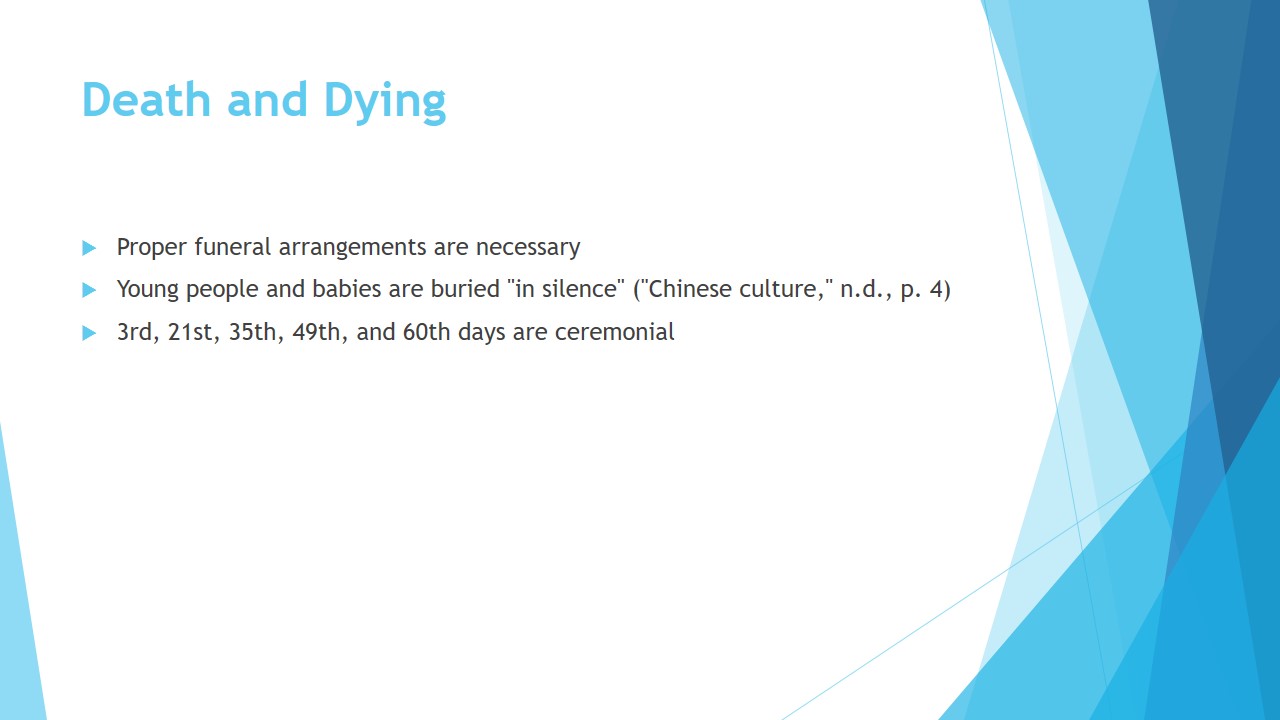
Spirituality
- Many individuals combine different religious practices.
- Buddhism is considered a lifestyle practice.
- Confucianism values five main virtues.
- Taoism highlights the modest living.
In most cases, the spiritual practices of the Chinese are a combination of religion and philosophy. For instance, Buddhism is viewed as an approach to living one’s life and not as merely a belief in a particular god. In this context, achieving enlightenment is the key, which will allow one to experience peace and wisdom. Main holidays include the New Year, the date of which differs from the New Year celebrated in Western cultures. Next, a significant holiday for Confucianists is Confucius’s’ birthday. Christian holidays are consistent with those celebrated by other cultural groups. Regardless of a specific religion, spiritually plays a vital role for the Chinese and is viewed as an integral part of society.
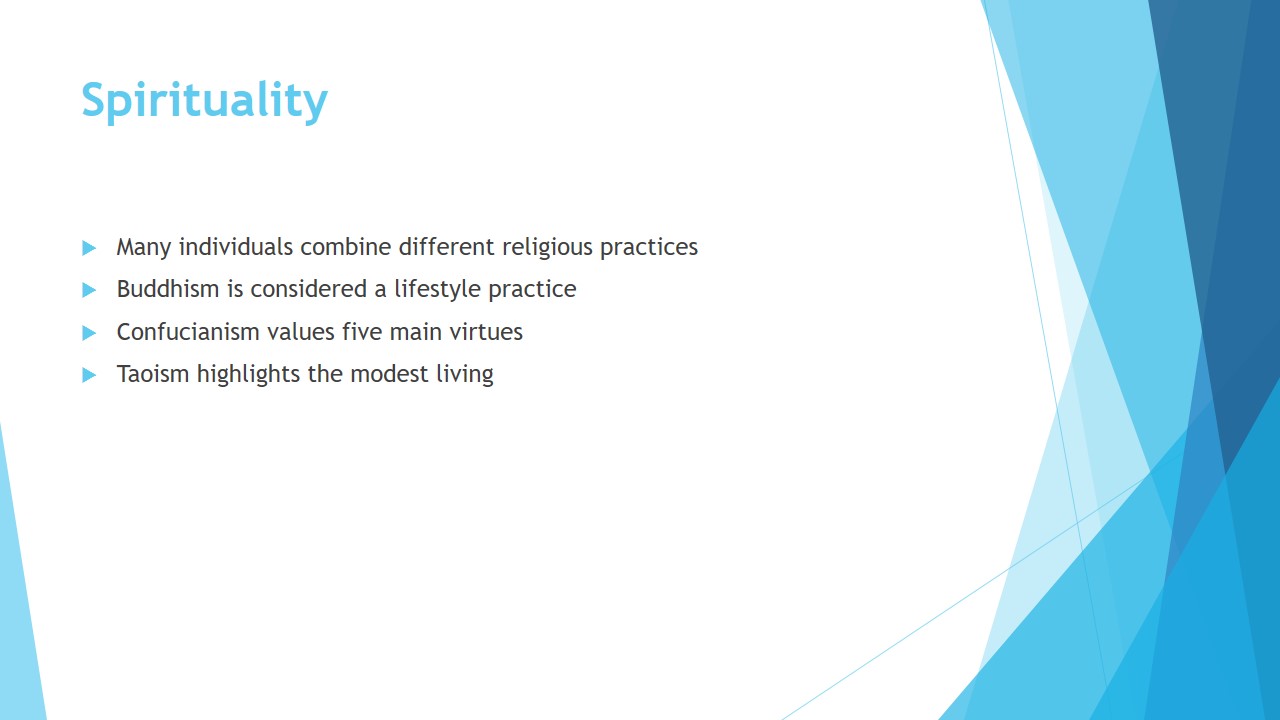
Prayer and Meditation
- Mantras and meditation are common for Buddhists.
- Other religions do not require prayers or meditation.
- Spirituality is highly valued in this community.
Due to the fact that the cultural group in question has diverse religious beliefs, it is difficult to define one specific approach to practicing a religion. Chinese Americans often combine beliefs of Stoicism, Buddhism, and Confucianism (Tung & Li, 2015). Hence, each subgroup may be adhering to different customs and religious practices. Christian individuals will pray and visit the church in accordance with standard practices prevalent in the United States. Other religions are closely connected to philosophy and thus target lifestyle changes and not prayers or other forms of worshipping. While spirituality is essential for the Chinese, in most cases, they display it through their living habits and behavior and not specific rituals.
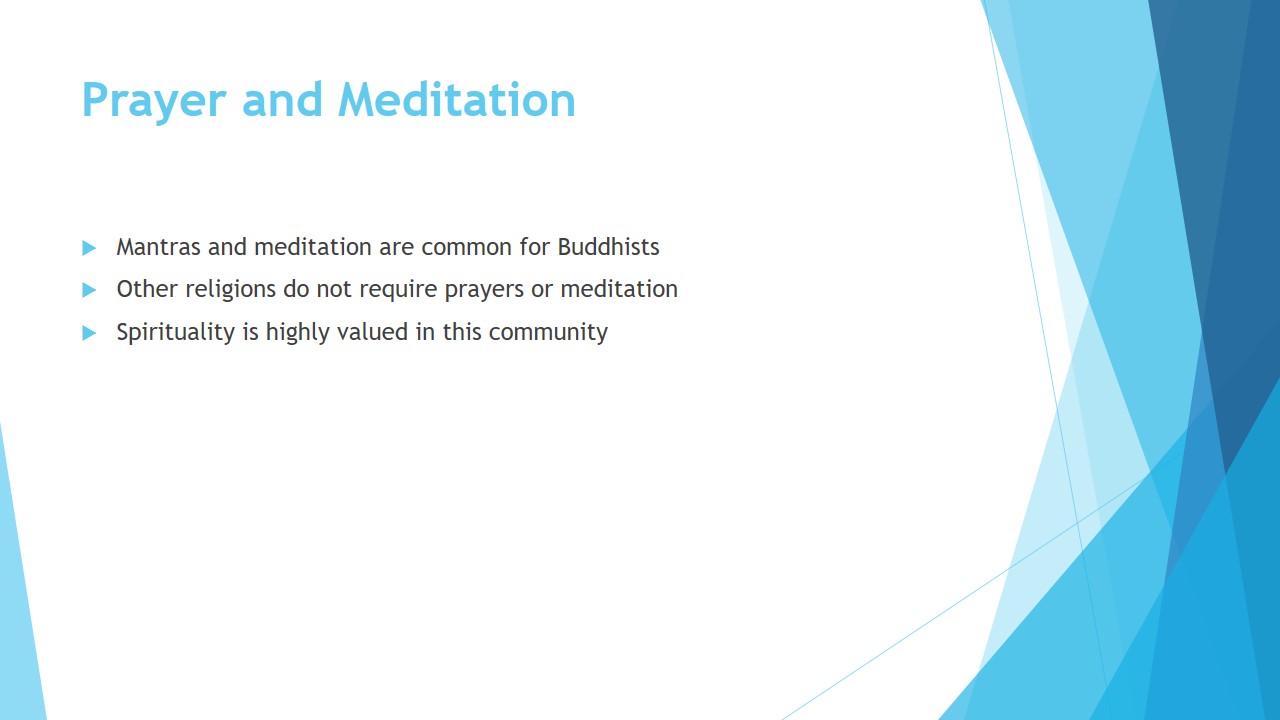
Gained Knowledge
- Specific attitudes towards pain.
- Yin-yang balance is the key to health.
- A balanced diet is a common choice.
- Traditional medicine is used by many (“Chinese culture,” n.d.).
The knowledge gained when exploring information about the Chinese culture group is extremely valuable for personal, professional practice. For instance, the fact that the Chinese can refuse to eat hospital food if they perceive it as not meeting their dietary needs is an important revelation that can improve care for this group (“Chinese culture,” n.d.). The most unusual knowledge piece about this cultural group is their perception and display of pain, which changes dramatically the approach to assessing symptoms and providing remedies. The positive aspect is the preference for a balanced diet that mitigates many difficulties associated with managing some diseases.
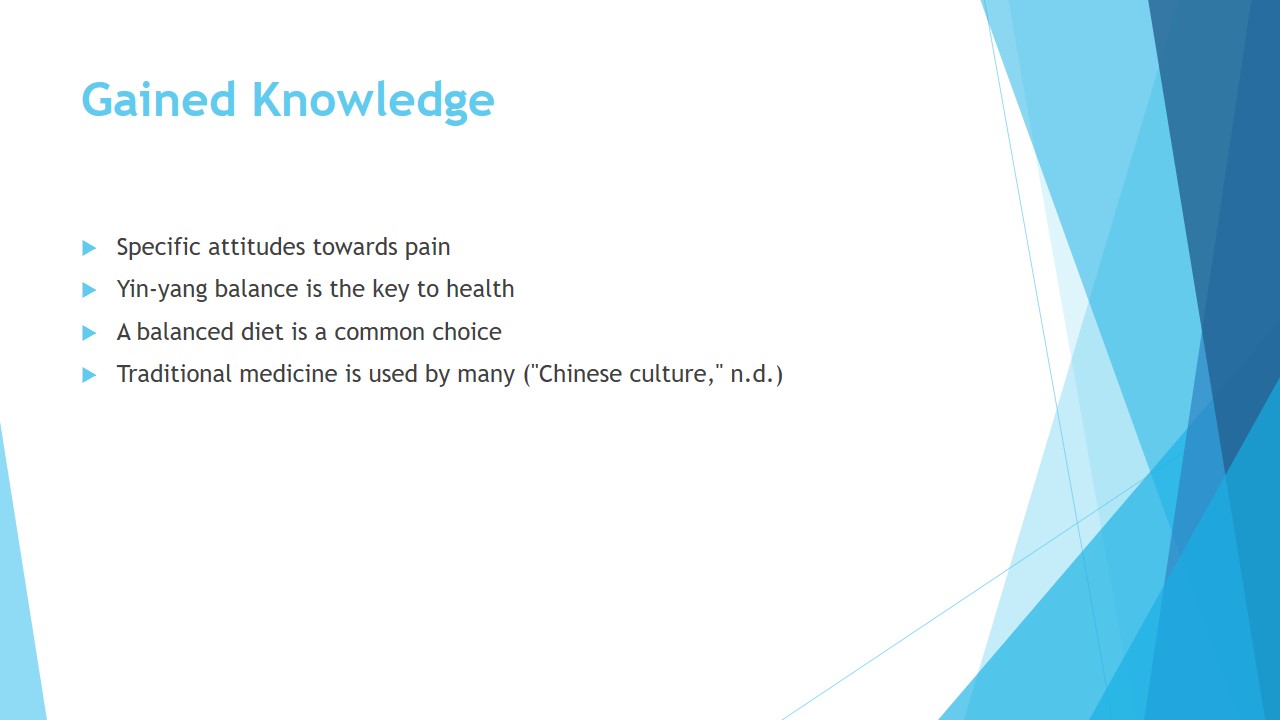
Changing Care Practices
Based on the knowledge about the Chinese culture, I will consider the following when providing care to this cultural group:
- The Chinese have a unique view of their health;
- The treatment process should incorporate the described ideas;
- Environment and family are integral to this population;
- Surgery and other invasive techniques may be rejected.
The information collected for this presentation will have a significant impact on the perception of Chinese culture and its specifics related to healthcare. It should be noted, however, that culture is a dynamic notion, meaning that not all Chinese people share opinions and beliefs described in this paper (Lim, 2015). Therefore, it is crucial to be attentive to a person’s needs and ask questions regarding his or her preferences and choices of care related practices while keeping in mind the specifics reviewed in this presentation.
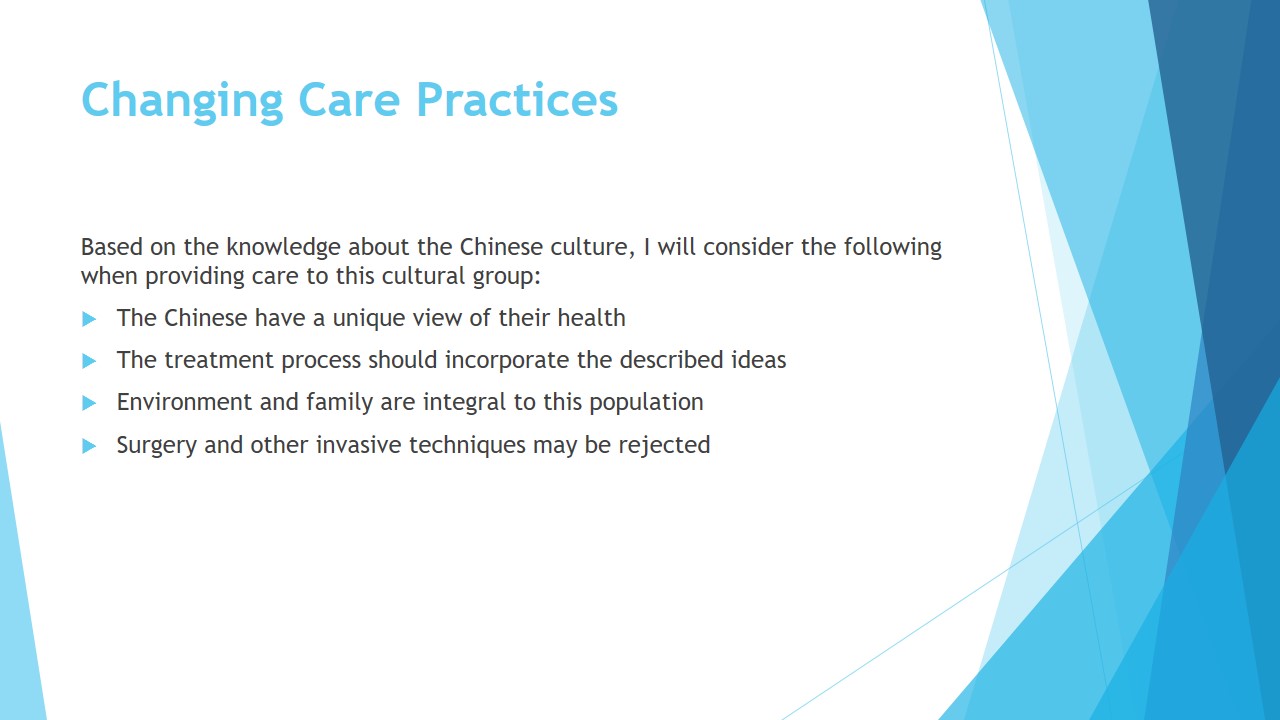
References
Chinese culture. (n.d.). Web.
Khlustov, Y. (2016). Tiktok: Time perceptions in China. Web.
Personal space in China. (n.d.). Web.
Tung, W.C., & Li, Z. (2015). Pain beliefs and behaviors among Chinese. Home Health Care Management & Practice, 27(2), 95–97. Web.